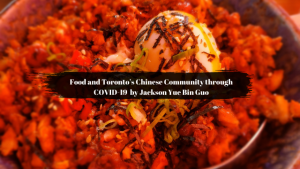 In February, the traffic flow between the Pacific Mall and the Silver Star Blvd, a Chinese food mecca for the Greater Toronto Area, could be best described by a Chinese proverb: “Carriages flow like a stream and horses whinny like dragons”. The tasty kebabs, boiling hotpots, and hand-pulled noodles sold in the mall normally drew crowds of diners from noon till night before the pandemic. Then, all of a sudden, by mid-March, silence engulfed the stores and alleys. Even the busiest restaurants shut their doors and closed their lights. “No eggs can remain unbroken when the nest is upset!” This other proverb echoed among Chinese Canadians, as COVID-19 scared the whole country and the world. But, going forward, could the pandemic provide any opportunities for the GTA’s astute Chinese-Canadian restaurateurs and food suppliers to regroup and recover? The Master of Huainan, an erudite Daoist scholar in the second century BCE left a famous story, “Elder Sai once lost a horse. His neighbours sent him consolation. Elder Sai smiled and said, ‘Who would know this is not a fortune?’ Days later, the horse returned with another.”
The creativity of ‘ethnic’ food markets in Toronto has attracted the notice of mainstream media and food studies scholarship only occasionally, and seldom in depth. The pandemic situation provides a rare opportunity to view the adaptability of the Chinese-Canadian food sector in a disrupted commercial environment. This blogpost explores how this sector has managed to deploy a strategy to function during the pandemic, largely aimed at customers familiar with Chinese-language social media tools. The rumours of possible food shortages circulating on social media if the pandemic alighted in Canada began as early as late January and early February, among Chinese-Canadians, who tend to be better informed than most Canadians about the everyday impact of COVID-19 in the affected regions of China. Although most Torontonians did not appear to be worried about the supply of fresh food, those who were well-informed about the horrendous situation in Wuhan hoarded canned foods, staples, and other food supplies. By March, the number of diagnosed patients in Canada was increasing exponentially. Rumours spread among Chinese-Canadians that all facilities and retailers would close sooner or later. At this point, Asian supermarkets such as T & T (by far the largest Asian food mart brand in Canada), Bestco and Foodymart quickly introduced new marketing tactics to accommodate the challenging business environment. Those tactics allowed them to successfully withstand the harshest days of disrupted food chains during late-spring and early-summer.
In February, the traffic flow between the Pacific Mall and the Silver Star Blvd, a Chinese food mecca for the Greater Toronto Area, could be best described by a Chinese proverb: “Carriages flow like a stream and horses whinny like dragons”. The tasty kebabs, boiling hotpots, and hand-pulled noodles sold in the mall normally drew crowds of diners from noon till night before the pandemic. Then, all of a sudden, by mid-March, silence engulfed the stores and alleys. Even the busiest restaurants shut their doors and closed their lights. “No eggs can remain unbroken when the nest is upset!” This other proverb echoed among Chinese Canadians, as COVID-19 scared the whole country and the world. But, going forward, could the pandemic provide any opportunities for the GTA’s astute Chinese-Canadian restaurateurs and food suppliers to regroup and recover? The Master of Huainan, an erudite Daoist scholar in the second century BCE left a famous story, “Elder Sai once lost a horse. His neighbours sent him consolation. Elder Sai smiled and said, ‘Who would know this is not a fortune?’ Days later, the horse returned with another.”
The creativity of ‘ethnic’ food markets in Toronto has attracted the notice of mainstream media and food studies scholarship only occasionally, and seldom in depth. The pandemic situation provides a rare opportunity to view the adaptability of the Chinese-Canadian food sector in a disrupted commercial environment. This blogpost explores how this sector has managed to deploy a strategy to function during the pandemic, largely aimed at customers familiar with Chinese-language social media tools. The rumours of possible food shortages circulating on social media if the pandemic alighted in Canada began as early as late January and early February, among Chinese-Canadians, who tend to be better informed than most Canadians about the everyday impact of COVID-19 in the affected regions of China. Although most Torontonians did not appear to be worried about the supply of fresh food, those who were well-informed about the horrendous situation in Wuhan hoarded canned foods, staples, and other food supplies. By March, the number of diagnosed patients in Canada was increasing exponentially. Rumours spread among Chinese-Canadians that all facilities and retailers would close sooner or later. At this point, Asian supermarkets such as T & T (by far the largest Asian food mart brand in Canada), Bestco and Foodymart quickly introduced new marketing tactics to accommodate the challenging business environment. Those tactics allowed them to successfully withstand the harshest days of disrupted food chains during late-spring and early-summer.
 In February, the traffic flow between the Pacific Mall and the Silver Star Blvd, a Chinese food mecca for the Greater Toronto Area, could be best described by a Chinese proverb: “Carriages flow like a stream and horses whinny like dragons”. The tasty kebabs, boiling hotpots, and hand-pulled noodles sold in the mall normally drew crowds of diners from noon till night before the pandemic. Then, all of a sudden, by mid-March, silence engulfed the stores and alleys. Even the busiest restaurants shut their doors and closed their lights. “No eggs can remain unbroken when the nest is upset!” This other proverb echoed among Chinese Canadians, as COVID-19 scared the whole country and the world. But, going forward, could the pandemic provide any opportunities for the GTA’s astute Chinese-Canadian restaurateurs and food suppliers to regroup and recover? The Master of Huainan, an erudite Daoist scholar in the second century BCE left a famous story, “Elder Sai once lost a horse. His neighbours sent him consolation. Elder Sai smiled and said, ‘Who would know this is not a fortune?’ Days later, the horse returned with another.”
The creativity of ‘ethnic’ food markets in Toronto has attracted the notice of mainstream media and food studies scholarship only occasionally, and seldom in depth. The pandemic situation provides a rare opportunity to view the adaptability of the Chinese-Canadian food sector in a disrupted commercial environment. This blogpost explores how this sector has managed to deploy a strategy to function during the pandemic, largely aimed at customers familiar with Chinese-language social media tools. The rumours of possible food shortages circulating on social media if the pandemic alighted in Canada began as early as late January and early February, among Chinese-Canadians, who tend to be better informed than most Canadians about the everyday impact of COVID-19 in the affected regions of China. Although most Torontonians did not appear to be worried about the supply of fresh food, those who were well-informed about the horrendous situation in Wuhan hoarded canned foods, staples, and other food supplies. By March, the number of diagnosed patients in Canada was increasing exponentially. Rumours spread among Chinese-Canadians that all facilities and retailers would close sooner or later. At this point, Asian supermarkets such as T & T (by far the largest Asian food mart brand in Canada), Bestco and Foodymart quickly introduced new marketing tactics to accommodate the challenging business environment. Those tactics allowed them to successfully withstand the harshest days of disrupted food chains during late-spring and early-summer.
In February, the traffic flow between the Pacific Mall and the Silver Star Blvd, a Chinese food mecca for the Greater Toronto Area, could be best described by a Chinese proverb: “Carriages flow like a stream and horses whinny like dragons”. The tasty kebabs, boiling hotpots, and hand-pulled noodles sold in the mall normally drew crowds of diners from noon till night before the pandemic. Then, all of a sudden, by mid-March, silence engulfed the stores and alleys. Even the busiest restaurants shut their doors and closed their lights. “No eggs can remain unbroken when the nest is upset!” This other proverb echoed among Chinese Canadians, as COVID-19 scared the whole country and the world. But, going forward, could the pandemic provide any opportunities for the GTA’s astute Chinese-Canadian restaurateurs and food suppliers to regroup and recover? The Master of Huainan, an erudite Daoist scholar in the second century BCE left a famous story, “Elder Sai once lost a horse. His neighbours sent him consolation. Elder Sai smiled and said, ‘Who would know this is not a fortune?’ Days later, the horse returned with another.”
The creativity of ‘ethnic’ food markets in Toronto has attracted the notice of mainstream media and food studies scholarship only occasionally, and seldom in depth. The pandemic situation provides a rare opportunity to view the adaptability of the Chinese-Canadian food sector in a disrupted commercial environment. This blogpost explores how this sector has managed to deploy a strategy to function during the pandemic, largely aimed at customers familiar with Chinese-language social media tools. The rumours of possible food shortages circulating on social media if the pandemic alighted in Canada began as early as late January and early February, among Chinese-Canadians, who tend to be better informed than most Canadians about the everyday impact of COVID-19 in the affected regions of China. Although most Torontonians did not appear to be worried about the supply of fresh food, those who were well-informed about the horrendous situation in Wuhan hoarded canned foods, staples, and other food supplies. By March, the number of diagnosed patients in Canada was increasing exponentially. Rumours spread among Chinese-Canadians that all facilities and retailers would close sooner or later. At this point, Asian supermarkets such as T & T (by far the largest Asian food mart brand in Canada), Bestco and Foodymart quickly introduced new marketing tactics to accommodate the challenging business environment. Those tactics allowed them to successfully withstand the harshest days of disrupted food chains during late-spring and early-summer.



